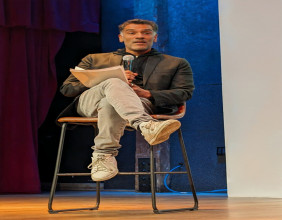PORT HENRY, NY, UNITED KINGDOM, October 24, 2024 /EINPresswire.com/ -- Lake Champlain, also known as "America's Loch Ness," is said to be home to a creature known as "Champ," an immense horned serpent. Stories of Champ go back to the native Abenaki and Iroquois tribes, who often paid homage to the horned serpents to allow them a safe passage. Strange hydrophone recordings from Lake Champlain were captured on September 20th, 2024, by longtime Champ field researcher Katy Elizabeth. During an expedition on Lake Champlain with her equipment-laden research vessel, Kelpie II, she deployed a hydrophone that captured various clicking followed by a buzzing noise between them. The sounds uniquely resemble echolocation exhibited by cetaceans like dolphins and whales but are uniquely complex.
Elizabeth's theory is that these unknown animals may have evolved to possess echolocation over centuries of living in the 120-mile-long lake that serves as a border for New York and Vermont. She stresses that over time, stories have been blown out of proportion to where it is believed to be just one animal that has survived a millennium and is 100 feet long when reports and sonar readings indicate creatures 15-30 feet long. Scientists theorize there would have to be at least 30-60 breeding pairs of these creatures to sustain a population. Elizabeth's theory of these animals being ectothermic and perhaps reptiles or amphibians would explain why these creatures would not have to eat large amounts of fish, as ectotherms do not need to consume large quantities of fish like mammals would.
In a comprehensive video posted on YouTube entitled "Scientific Analysis of the September 20, 2024, Echolocation Recordings Captured in Lake Champlain,"
, she makes a case for the sounds being biological sonar by providing similar clicks from various whales and dolphins.
The hydrophone capture from September 20th is the third time strange and unidentified echolocation sounds have been detected at Lake Champlain. Past recordings were captured by bio acoustician Elizabeth von Muggenthaler in 2002 and Katy Elizabeth in 2014 and 2018. Additionally, over the past twelve years, Elizabeth has captured video and sonar readings that Japanese scientists and scientists for programs on the History Channel, Discovery Channel, and the Science Channel found that they were "unlike any species known to be in a freshwater lake."
Katy Elizabeth shared the recordings with Cindy Joli, a marine biologist from Perth, Australia, and a graduate of Marine Biology from Murdoch University. She was amazed at the complex nature of these sounds. Her analysis is as follows.
"Many animals can create underwater sounds for various purposes such as communication, hunting, and navigation. This consists of fishes, amphibians, reptiles, and aquatic mammals. The sounds recorded in Lake Champlain resemble intricate clicks employed for echolocation, like the ones produced by present-day toothed whales.
If the sounds belong to a marine mammal, there will be ongoing sightings as these animals need to surface frequently for air. The absence of living cetaceans in the lake makes it unlikely that the sounds are coming from these animals. The lake holds several species of reptiles and amphibians, with some species can remain submerged for longer durations than any marine mammal and carry out hibernation during winter. Certain amphibians and reptiles, such as newts and turtles, can create clicks underwater, although they are not as complex as the sounds captured.
The audio suggests the possibility of an unknown species, unlike anything known from a freshwater lake. The theory that a highly evolved "ectothermic animal" that can produce complex clicks resides in the lake is possible."
With this scientific breakthrough, Katy Elizabeth will continue bioacoustics studies on Lake Champlain in hopes of proving this species to science and enforcing further protection as well as the environmental aspects of hopefully keeping millions of gallons of sewage from flowing into Lake Champlain, which has occurred many times in recent years. In 2018, Elizabeth wrote a New York state law to protect these animals. The law was passed unanimously by the NY state legislature.
for more information
www.katyelizabeth.org
Katy Elizabeth
International Dracontology Alliance
+1 689-230-2399
email us here
Legal Disclaimer:
EIN Presswire provides this news content "as is" without warranty of any kind. We do not accept any responsibility or liability for the accuracy, content, images, videos, licenses, completeness, legality, or reliability of the information contained in this article. If you have any complaints or copyright issues related to this article, kindly contact the author above.
![]()





